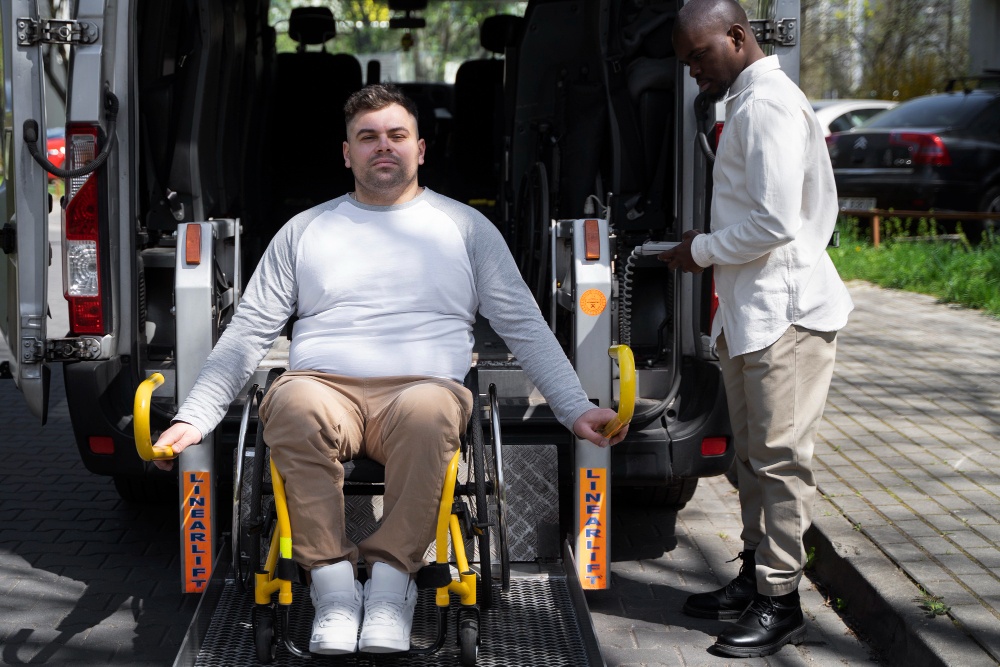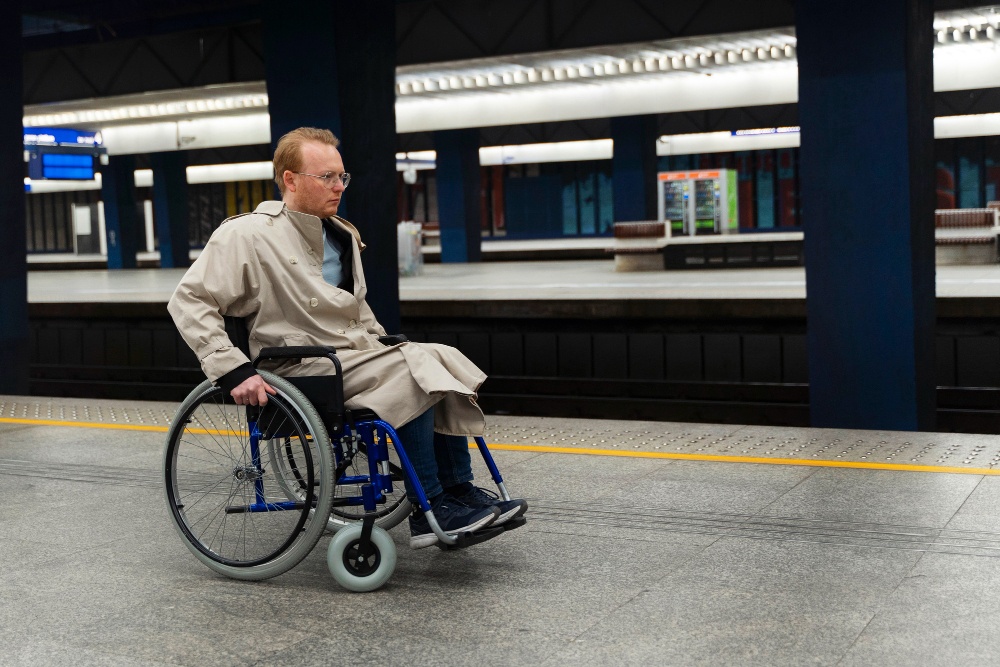Best Practices for Safe Transport Of Obese Patients
Transporting obese patients involves careful planning, specialized equipment, and trained personnel....
Created by: Daniel Ogunsemowo /
Vetted by:
Otse Amorighoye

Introduction: Understanding the Challenges of Transporting Obese Patients
With the prevalence of obesity on the rise globally, the healthcare industry faces a significant challenge in accommodating the unique needs of obese patients, especially during transportation. Traditional transportation methods often fall short of providing the necessary support, safety, and comfort for individuals who require specialized care.
According to the World Health Organization (WHO), the global prevalence of obesity nearly tripled between 1975 and 2020. In the United States alone, over 42% of adults are classified as obese, and a growing percentage face severe obesity. This surge creates a pressing need for tailored transportation options that safeguard patients' health and dignity.
Specialized bariatric transportation services have become an essential solution, with equipment and procedures designed to offer comfort and protection. By understanding the best ways to transport obese patients, healthcare providers, caregivers, and family members can make informed decisions, ensuring every transport is safe and dignified.
DreamCareRides is dedicated to providing compassionate, professional transportation services for obese patients. Contact us today to learn more about how our specialized solutions can cater to your loved one’s needs.
The Need for Specialized Bariatric Transportation Services
Transporting an obese patient requires more than just a standard vehicle and basic safety measures. Obese patients, particularly those who are severely or morbidly obese, often face unique physical, medical, and logistical challenges during transportation. These may include:
Physical Limitations: Traditional wheelchairs and stretchers are often not designed to hold higher weights comfortably, creating discomfort or potential injury.
Safety Concerns: Moving patients improperly can lead to slips, falls, or strain injuries, both for the patient and the caregivers.
Medical Needs: Obese patients frequently have associated health conditions, such as respiratory issues, cardiovascular disease, and diabetes, which require medical oversight during transit.
Use of Bariatric-Specific Transportation Services
Bariatric transportation services are designed specifically to meet the needs of obese patients. Here’s how they address key requirements:
1. Specialized Equipment
Heavy-Duty Stretchers: Bariatric stretchers are reinforced to hold weights significantly beyond standard stretchers, providing safety and comfort.
Wide-Bodied Wheelchairs: These wheelchairs are designed with a broader frame, offering extra space and weight capacity.
Hydraulic Lifts: To minimize strain and injury risk for both patients and caregivers, hydraulic lifts are used to transfer patients in and out of the vehicle safely.
2. Trained Personnel
Bariatric transport teams are skilled in the safe handling and mobility of obese patients. They are trained in specialized lifting techniques and patient care during transport, reducing the risk of injury.
3. Medical Monitoring Equipment
Many bariatric transportation services come equipped with monitoring devices to track vital signs and medical conditions during transit, especially for patients with high-risk health profiles.
4. Spacious Vehicles
Bariatric transport vans and ambulances offer larger interiors, allowing patients to travel comfortably without feeling restricted or at risk.
Best Ways to Transport an Obese Patient
When planning transport for an obese patient, certain best practices can help ensure the process is safe, comfortable, and efficient.
1. Conduct a Pre-Transport Assessment
Assess the patient’s physical needs, weight, mobility restrictions, and any health risks. This can guide equipment selection and ensure the transportation process is safe from start to finish.
2. Choose Appropriate Equipment
Using bariatric-specific equipment is vital. Regularly assess and ensure that stretchers, wheelchairs, and lifting devices are suitable for the patient’s weight and condition.
3. Engage Trained Professionals
Ensure that the transport team is experienced in handling obese patients and understands their unique medical needs. Certified bariatric transport teams can offer professional support to reduce risks and enhance comfort.
4. Ensure Continuous Monitoring During Transit
If the patient has underlying health conditions, continuous monitoring is essential. This includes tracking heart rate, oxygen levels, and respiratory status, allowing for swift responses to any medical changes.
5. Select the Right Transportation Service Provider
Look for a service that specializes in bariatric transportation, like DreamCareRides, which is equipped to handle the unique requirements of obese patients. These providers typically offer necessary medical monitoring, trained staff, and patient-centered transportation solutions.
FAQs About Transporting Obese Patients
1. What weight limit do bariatric stretchers and wheelchairs support?
Bariatric stretchers can support between 500 to 1,000 pounds, depending on the model. Wide-bodied wheelchairs also have higher weight limits, generally supporting up to 850 pounds, offering additional room for comfort.
2. How does bariatric transportation differ from standard medical transportation?
Bariatric transportation uses specialized equipment, larger vehicles, and trained personnel to ensure safe, dignified transport for obese patients. This reduces the risk of injury and ensures the patient’s comfort.
3. Can bariatric transport services accommodate long-distance travel?
Yes, many bariatric transportation providers offer long-distance services, but arrangements should be made in advance to account for the patient's medical needs, comfort, and any necessary stops along the way.
4. Are bariatric transportation services covered by insurance?
Some insurance providers cover bariatric transportation if it’s deemed medically necessary. Check with your insurance provider to confirm coverage and any prerequisites for reimbursement.
5. How can I arrange bariatric transportation for a loved one?
To arrange bariatric transportation, contact a specialized service provider like DreamCareRides. Be ready to provide information about the patient’s weight, mobility needs, medical conditions, and any specific transport requirements.
Conclusion: Ensuring Safe and Dignified Transportation for Obese Patients
Transporting obese patients involves careful planning, specialized equipment, and trained personnel. By using dedicated bariatric transportation services, patients can experience a dignified journey that prioritizes their safety, comfort, and health.
Contact DreamCareRides Today
For safe, reliable, and professional bariatric transportation, contact DreamCareRides. Our team is committed to ensuring every journey is handled with care, expertise, and compassion, making transportation as seamless and comfortable as possible. Reach out today to learn more about our services and how we can assist you and your loved ones.
10 Top Benefits of Non-Emergency Medical Transportation for Patients and Healthcare Providers How Our NEMT Service Helps You Get to Your Appointments on Time, Every Time Booking NEMT Services for Family Members: What You Need to Know How Our NEMT Service Supports Last-Minute and Urgent Ride Requests Why Choose DreamCareRides for Elderly and Disabled Transportation in Chicago?Related Articles
Recent blog posts

Daniel Ogunsemowo
Nov 08, 2024
Medical Transportation
7 Things to Consider Before Booking NEMT for Dialysis Appointments
When it comes to dialysis treatment, transportation is essential. ...

Daniel Ogunsemowo
Nov 08, 2024
Medical Transportation
How NEMT Supports Post-Surgery Care
Post-surgery recovery often demands strict adherence to healthcare schedules for follow-up visits, p ...

Daniel Ogunsemowo
Nov 07, 2024
Medical Transportation
10 Illinois Medicaid Transportation Providers: Top Choices for NEMT Services
In Illinois, access to healthcare depends on the availability of reliable transportation for Medicai ...

Adeshola Bello
Nov 04, 2024
Medical Transportation
Essential Airport Transportation Tips for Disabled Travelers
Traveling can be an exciting adventure, but for disabled travelers, it often comes with unique chall ...

Daniel Ogunsemowo
Nov 04, 2024
Medical Transportation
Ensuring On-Time Medical Appointments for Chicago Patients with DreamCareRides
Every year, thousands of Chicago patients face the challenge of reaching their medical appointments ...

Daniel Ogunsemowo
Nov 04, 2024
Medical Transportation
10 Meaningful Ways to Spend Quality Time with Your Grandparents During Christmas
The holiday season is the perfect time to create lasting memories with your loved ones, especially g ...